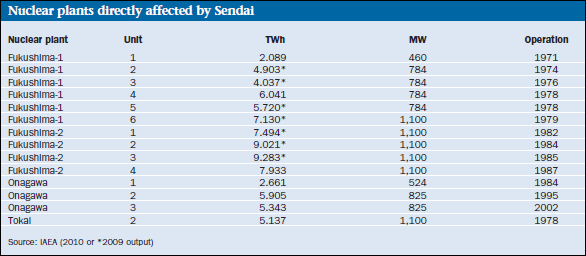Impact on Japan’s nuclear power sector will be profound
March 17, 2011 - The full impact of the 9.0-magnitude earthquake and resultant tsunami in northeastern Japan on March 11 remains to be determined. But the impact on the country's nuclear power sector and wider energy market will be profound. (See related map: Japanese earthquake impact).
In the immediate aftermath of the disaster 11 reactors at four sites shut down automatically. (See related table: Nuclear plants directly affected by Sendai).
The Japan Atomic Power Company's 1,100-megawatt Tokai Daini reactor in Ibaraki prefecture shut down without apparent problems, although the company said on March 13 that two of the three diesel generators used for emergency cooling had subsequently failed.
Meanwhile a fire occurred immediately after the disaster in a turbine building at one of the three reactors - all automatically shut down - at Tohoku Electric Power Company's 2,174-MW Onagawa plant in Miyagi prefecture. It was extinguished without indications at the time of radioactive leakage, the company said.
Tohoku Electric subsequently said on March 12 that radiation levels at Onagawa had surged.
But by March 14 radiation had fallen to normal levels, according to the International Atomic Energy Agency, which added that "the current assumption of the Japanese authorities is that the increased level may have been due to a release of radioactive material from the Fukushima Daiichi nuclear power plant."
Fukushima, which has experienced the worst problems to date, comprises two plants located 11.5 kilometers apart.
Fukushima Daiichi (Fukushima-1) and Fukushima Daini (Fukushima-2) are both owned and operated by the Tokyo Electric Power Company (Tepco), with the Fukushima-1 complex comprising six boiling water reactors with about 4,700 MW of capacity, while Fukushima-2 comprises four boiling water reactors with 4,400 MW of capacity.
All four Fukushima-2 reactors were operating at the time of the earthquake and shut down automatically, as did three units at the Fukushima-1 complex. The remaining three reactors at Fukushima-1 were already shut for scheduled maintenance.
The automatic shutdown of the Fukushima-2 reactors ran into cooling problems when emergency generators failed, mainly as a result of the tsunami.
Similar but much worse problems then emerged at Fukushima-1. On March 12, following emergency cooling problems, the structure housing the No.1 reactor at Fukushima-1 collapsed following a hydrogen explosion.
The explosion was accompanied by a surge in radiation levels, which led to the establishment of a 20-km cordon sanitaire round the plant.
Since February this year, the prices of CME have risen sharply to around Pesos 118/liter, while diesel prices remain at Pesos 36-38/liter.
Attention then shifted to cooling problems at the No.3 reactor at Fukushima-1. On March 14 the problems culminated in a hydrogen explosion at that unit as well.
March 14 also saw cooling problems emerge at Fukushima-1's No.2 reactor. Fears of an explosion there - the third overall - were realized on March 15, when there was also a fire at the No.4 reactor, which had been closed at the time of the disaster.
At the same time the government warned that radiation levels at Fukushima-1 had reached harmful levels amid fears that at least one of the reactors' containment vessels had been damaged.
The exact causes and outcomes of the various reactor problems remained unclear as Power in Asia went to press, and will probably remain unclear for some time to come.
Nailing down the causes of nuclear incidents can be problematic, given the complexity of the forces at work.
To subscribe or visit go to: http://www.platts.com
![]()
